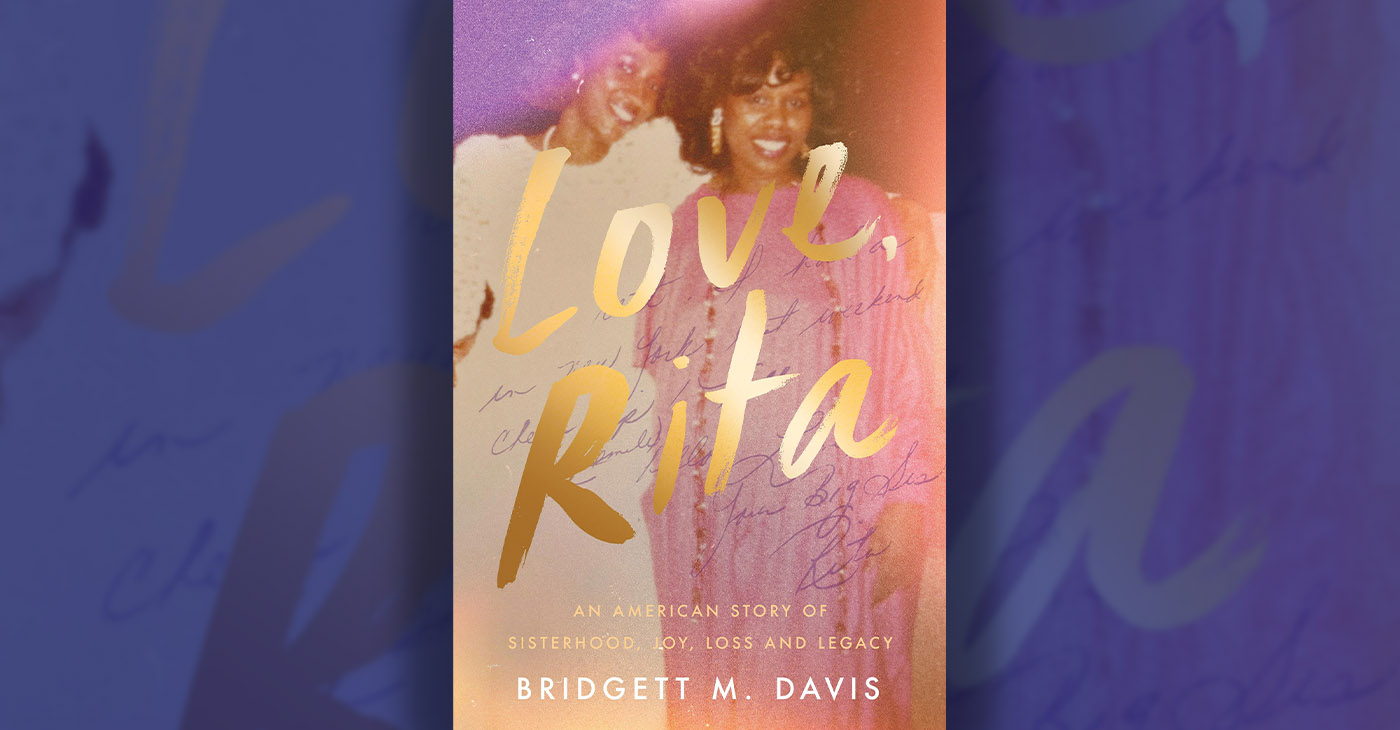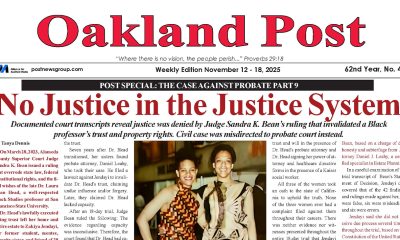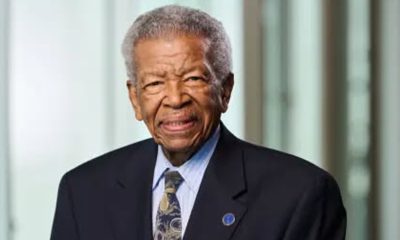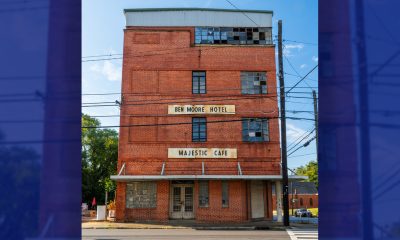Book Reviews
Using a Bicycle, Author Follows Roads to Freedom Taken by Harriet Tubman on Underground Railroad
In the early spring of 2011, while taking a rest from a cold bike ride, David Goodrich wandered into a museum. There, he was handed a large brass ring that was once a slave collar. It reminded him of something he knew: one of his ancestors was a ship’s captain in the “Triangle Trade,” also known as the Atlantic Slave Trade.

By Terri Schlichenmeyer
The Bookworm Sez, LLC
It’s all in the balance.
You need to maintain that first and everything else comes next. Without balance, you can’t pedal and the wheels won’t turn. Without balance, you’d dream of a place with no chance of biking there. No balance, no movement — and, as in the new book, “On Freedom Road” by David Goodrich, forward, northward, is the only way to go.
In the early spring of 2011, while taking a rest from a cold bike ride, David Goodrich wandered into a museum. There, he was handed a large brass ring that was once a slave collar.
It reminded him of something he knew: one of his ancestors was a ship’s captain in the “Triangle Trade,” also known as the Atlantic Slave Trade.
Holding the collar and acknowledging that “white folks like him” have different ties to slavery than do Black Americans, he yearned to “discover how some … [African] descendants later brought themselves to freedom.”
In 2015 and 2017, he and a friend had taken trips from New Orleans, Louisiana, and Jackson, Mississippi, respectively, following routes that enslaved people might have been forced to travel. He writes about those trips in later pages here, but he begins this book near the birthplace of Harriet Tubman.
To find Tubman’s exact route north on the Underground Railroad took some effort, Goodrich says, because she was illiterate and written details could have been dangerous. Still, there were notes and clues indicating where she went. She tried not to attract attention but the owners of the safe houses along her route knew her. Those facts helped shape the journey that Goodrich and two fellow riders took in the summer of 2019.
From Maryland to Canada, they biked up hills, through wooded areas and mud, following an app, notes, roadside signage, and traveled along many of the same roads that Tubman had made repeatedly under cover of night, despite threats on her life and that of her ‘passengers.’
As for Goodrich and friends, “we would be traveling by daylight, without dogs in pursuit, and with the benefit of Gore-Tex, shiny gears, and freedom.”
“On Freedom Road” is a pleasantly odd read.
The timeline, first of all, is backwards: author David Goodrich opens this book with a recent tale, leaving a later journey for the back half. It’s somewhat befuddling.
And yet, neither part lacks in excitement: because a bicycle isn’t a car, Goodrich had a vantage point that’s unique in travelogues, which is at least partly what this book is. Readers will find descriptions of bicycling and scenery, yet it doesn’t distract from history, which is the reason behind the ride. The nimbleness of the transportation mode helps Goodrich share the smallest, bravest, most impactfully historic tales of danger, determination and daring.
“On Freedom Road” is not filled with the tales you learned in school; no, it recounts the wild and violent and heroic, told between gentle accounts of weather, traffic and flat tires. Readers who are looking for something unusual will find that to be a nice balance.
“On Freedom Road: Bicycle Explorations and Reckonings on the Underground Railroad” by David Goodrich. c. 2023, Pegasus $27.95 246 pages
Arts and Culture
Book Review: American Kings – A Biography of the Quarterback
Wickersham calls his book “a biography,” but it’s just as much a history, since he refers often to the earliest days of the game, as well as the etymology of the word “quarterback.” That helps to lay a solid background, and it adds color to a reader’s knowledge about football itself, while explaining what it takes for men and women to stand out and to achieve gridiron greatness.

By Terri Schlichenmeyer
Author: Seth Wickersham, Copyright: c.2025, Publisher: Hyperion Avenue, Price: $29.99, Page Count: 407 pages
Snap.
And with that, and a catch that’s picture-perfect, your team is on its way to another win. The guy that threw the football sure knows his stuff. He’s worth every penny he’s paid, and in the new book “American Kings” by Seth Wickersham, you’ll see what it took to get there.
Like so many little boys, Wickersham wanted to play pro football when he was growing up; specifically, he wanted to be a quarterback. Unlike most other boys, though, he took it to an extreme, becoming “obsessed” with throwing a football with the best accuracy, hoping to match the skills of the players he admired.
Alas, despite an entire childhood of near-constant practice and a few wins on the field in high school, he didn’t make varsity and ended up playing as a receiver.
He knows now that to be a quarterback is to be a star, but it’s also “a way of life.”
Here, he writes about Arch Manning, “a legend, a folk hero, a song title… and the beginning of a family franchise…” Wickersham shares the story of Warren Moon, how he stepped up to help his mother when his father died, how domestic violence almost derailed his legacy, and the racism he quarterbacked under for years.
He spent time with Caleb Williams, “the first true professional amateur quarterback” to get money for playing at the college level. He interviewed James Harris, who was prepared to become a teacher “If the league didn’t want a Black quarterback…” Wickersham “spent much of 2022 with” Andrew Luck, who “learned quickly that greatness requires an… unlimited selfishness.” He writes about how Jack Elway influenced his son’s choice of career, what Hollywood had to do with one pro footballer’s life, and the post-career of the first player “to throw a consistently beautiful spiral.”
Says Wickersham about his subjects, “Anyone could throw a football. Only a quarterback could make people cheer.”
Your favorite chair is oiled for smooth reclining and fast slam-downs. The snacks are laid in for at least a week, and beverages are on ice. You know exactly what you’re wearing for the game this weekend. All you need is “American Kings” and you’re set.
Wickersham calls his book “a biography,” but it’s just as much a history, since he refers often to the earliest days of the game, as well as the etymology of the word “quarterback.” That helps to lay a solid background, and it adds color to a reader’s knowledge about football itself, while explaining what it takes for men and women to stand out and to achieve gridiron greatness. On that. Wickersham is honest, sometimes calling out his subjects for their attitudes toward teammates and others. Blunt words are used that are unprintable in family newspapers, so beware if you’re sharing.
Is your team’s QB in this book? Maybe. But, more than likely, a past favorite is, So, check out “American Kings” and see what you find. Football fans and pigskin prognosticators both will love this book in a snap.
Activism
BOOK REVIEW: The Afterlife of Malcolm X
Betty Shabazz didn’t like to go to her husband’s speeches, but on that February night in 1965, he asked her to come with their daughters to the Audubon Ballroom in New York. Did Malcolm X sense that something bad would happen on that night? Surely. He was fully aware of the possibility, knowing that he’d been “a marked man” for months because of his very public break with the Nation of Islam.

By Terri Schlichenmeyer
Author: by Mark Whitaker, c.2025, Simon & Schuster, $30.99, 448 pages
Who will remember you in fifty years’ time?
A handful of friends – at least those who are still around – might recall you. Your offspring, grandkids, and greats, maybe people who stumble upon your tombstone. Think about it: who will remember you in 2075? And then read “The Afterlife of Malcolm X” by Mark Whitaker and learn about a legacy that still resonates a half-century later.
Betty Shabazz didn’t like to go to her husband’s speeches, but on that February night in 1965, he asked her to come with their daughters to the Audubon Ballroom in New York. Did Malcolm X sense that something bad would happen on that night? Surely. He was fully aware of the possibility, knowing that he’d been “a marked man” for months because of his very public break with the Nation of Islam.
As the news of his murder spread around New York and around the world, his followers and admirers reacted in many ways. His friend, journalist Peter Goldman, was “hardly shocked” because he also knew that Malcolm’s life was in danger, but the arrest of three men accused of the crime didn’t add up. It ultimately became Goldman’s “obsession.”
Malcolm’s co-writer for The Autobiography of Malcolm X, Alex Haley, quietly finished the book he started with Malcolm, and a small upstart publishing house snatched it up. A diverse group of magazines got in line to run articles about Malcolm X’s life, finally sensing that White America “’needed his voice even more than Blacks did.’”
But though Malcolm X was gone, he continued to leave an impact.
He didn’t live long enough to see the official founding of the Black Panther Party, but he was influential on its beginning. He never knew of the first Kwanzaa, or the triumphs of a convert named Muhammad Ali.
Malcolm left his mark on music. He influenced at least three major athletes.
He was a “touchstone” for a president …
While it’s true that “The Afterlife of Malcolm X” is an eye-opening book, one that works as a great companion to the autobiography, it’s also a fact that it’s somewhat scattered. Is it a look at Malcolm’s life, his legacy, or is it a “murder mystery”?
Turns out, it’s all three, but the storylines are not smooth. There are twists and tangents and that may take some getting used-to. Just when you’re immersed, even absorbed in this book, to the point where you forget about your surroundings, author Mark Whitaker abruptly moves to a different part of the story. It may be jarring.
And yet, it’s a big part of this book, and it’s essential for readers to know the investigation’s outcome and what we know today. It doesn’t change Malcolm X’s legacy, but it adds another frame around it.
If you’ve read the autobiography, if you haven’t thought about Malcolm X in a while, or if you think you know all there is to know, then you owe it to yourself to find “The Afterlife of Malcolm X.”
For you, this is a book you won’t easily forget.
Arts and Culture
BOOK REVIEW: Love, Rita: An American Story of Sisterhood, Joy, Loss, and Legacy
When Bridgett M. Davis was in college, her sister Rita was diagnosed with lupus, a disease of the immune system that often left her constantly tired and sore. Davis was a bit unfazed, but sympathetic to Rita’s suffering and also annoyed that the disease sometimes came between them. By that time, they needed one another more than ever.

By Terri Schlichenmeyer
Author: Bridgett M. Davis, c.2025, Harper, $29.99, 367 Pages
Take care.
Do it because you want to stay well, upright, and away from illness. Eat right, swallow your vitamins and hydrate, keep good habits and hygiene, and cross your fingers. Take care as much as you can because, as in the new book, “Love, Rita” by Bridgett M. Davis, your well-being is sometimes out of your hands.
It was a family story told often: when Davis was born, her sister, Rita, then four years old, stormed up to her crying newborn sibling and said, ‘Shut your … mouth!’
Rita, says Davis, didn’t want a little sister then. She already had two big sisters and a neighbor who was somewhat of a “sister,” and this baby was an irritation. As Davis grew, the feeling was mutual, although she always knew that Rita loved her.
Over the years, the sisters tried many times not to fight — on their own and at the urging of their mother — and though division was ever present, it eased when Rita went to college. Davis was still in high school then, and she admired her big sister.
She eagerly devoured frequent letters sent to her in the mail, signed, “Love, Rita.”
When Davis was in college herself, Rita was diagnosed with lupus, a disease of the immune system that often left her constantly tired and sore. Davis was a bit unfazed, but sympathetic to Rita’s suffering and also annoyed that the disease sometimes came between them. By that time, they needed one another more than ever.
First, they lost their father. Drugs then invaded the family and addiction stole two siblings. A sister and a young nephew were murdered in a domestic violence incident. Their mother was devastated; Rita’s lupus was an “added weight of her sorrow.”
After their mother died of colon cancer, Rita’s lupus took a turn for the worse.
“Did she even stand a chance?” Davis wrote in her journal.
“It just didn’t seem possible that she, someone so full of life, could die.”
Let’s start here: once you get past the prologue in “Love, Rita,” you may lose interest. Maybe.
Most of the stories that author Bridgett M. Davis shares are mildly interesting, nothing rare, mostly commonplace tales of growing up in the 1960s and ’70s with a sibling. There are a lot of these kinds of stories, and they tend to generally melt together. After about fifty pages of them, you might start to think about putting the book aside.
But don’t. Not quite yet.
In between those everyday tales, Davis occasionally writes about being an ailing Black woman in America, the incorrect assumptions made by doctors, the history of medical treatment for Black people (women in particular), attitudes, and mythologies. Those passages are now and then, interspersed, but worth scanning for.
This book is perhaps best for anyone with the patience for a slow-paced memoir, or anyone who loves a Black woman who’s ill or might be ill someday. If that’s you and you can read between the lines, then “Love, Rita” is a book to take in carefully.
-

 Activism3 weeks ago
Activism3 weeks agoOakland Post: Week of November 12 – 18, 2025
-

 Activism4 weeks ago
Activism4 weeks agoOakland Post: Week of November 5 – 11, 2025
-

 Activism2 weeks ago
Activism2 weeks agoIN MEMORIAM: William ‘Bill’ Patterson, 94
-

 Activism3 weeks ago
Activism3 weeks agoHow Charles R. Drew University Navigated More Than $20 Million in Fed Cuts – Still Prioritizing Students and Community Health
-

 Bay Area3 weeks ago
Bay Area3 weeks agoNo Justice in the Justice System
-

 #NNPA BlackPress3 weeks ago
#NNPA BlackPress3 weeks agoThe Perfumed Hand of Hypocrisy: Trump Hosted Former Terror Suspect While America Condemns a Muslim Mayor
-

 #NNPA BlackPress2 weeks ago
#NNPA BlackPress2 weeks agoTrump’s Death Threat Rhetoric Sends Nation into Crisis
-

 #NNPA BlackPress3 weeks ago
#NNPA BlackPress3 weeks agoProtecting Pedophiles: The GOP’s Warped Crusade Against Its Own Lies
























































